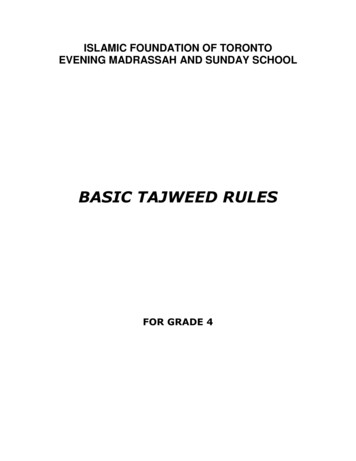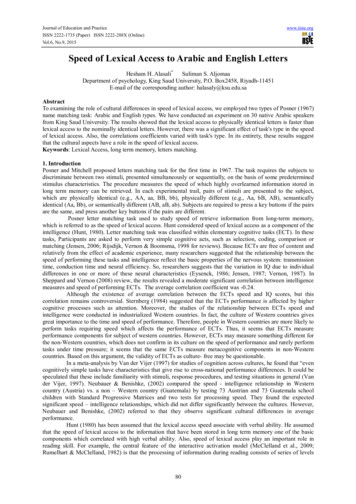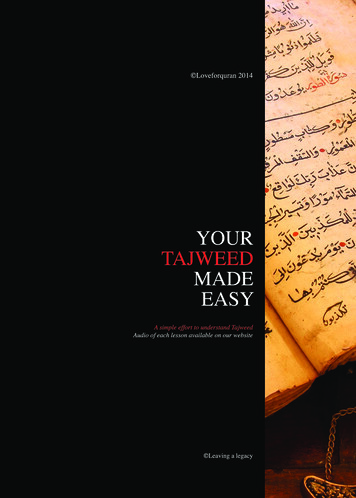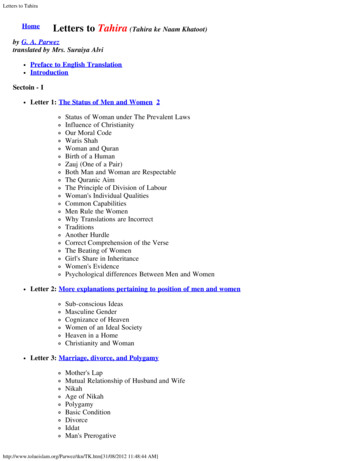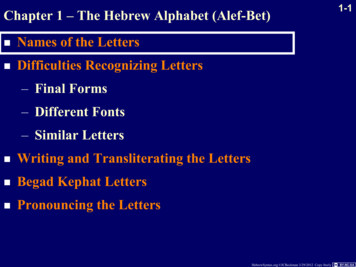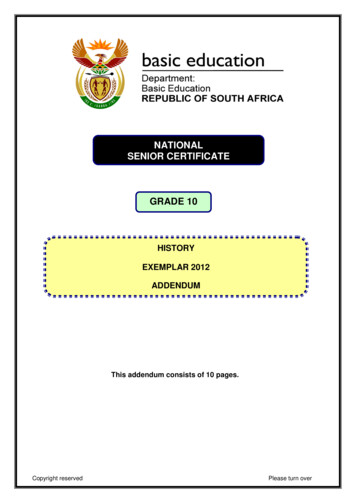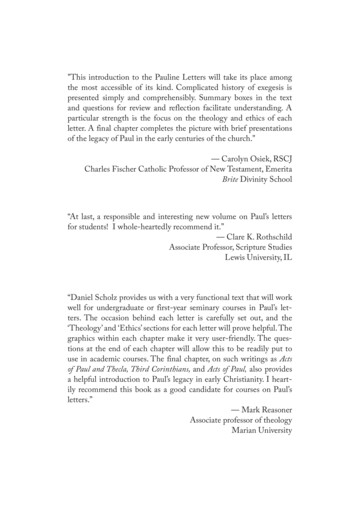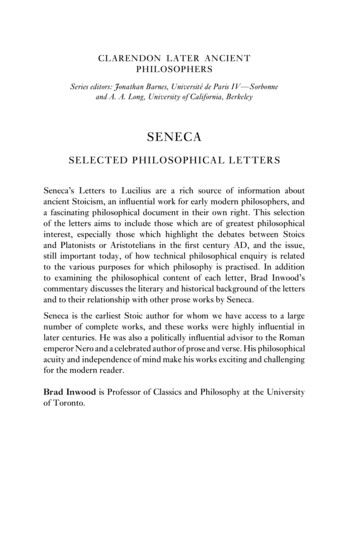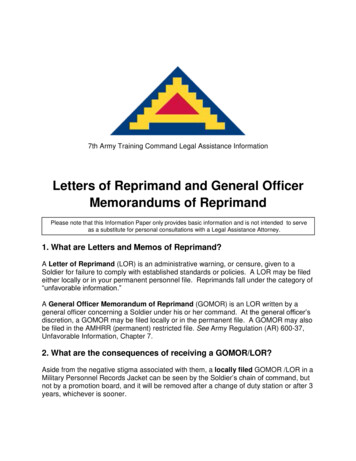
Transcription
7th Army Training Command Legal Assistance InformationLetters of Reprimand and General OfficerMemorandums of ReprimandPlease note that this Information Paper only provides basic information and is not intended to serveas a substitute for personal consultations with a Legal Assistance Attorney.1. What are Letters and Memos of Reprimand?A Letter of Reprimand (LOR) is an administrative warning, or censure, given to aSoldier for failure to comply with established standards or policies. A LOR may be filedeither locally or in your permanent personnel file. Reprimands fall under the category of“unfavorable information.”A General Officer Memorandum of Reprimand (GOMOR) is an LOR written by ageneral officer concerning a Soldier under his or her command. At the general officer’sdiscretion, a GOMOR may be filed locally or in the permanent file. A GOMOR may alsobe filed in the AMHRR (permanent) restricted file. See Army Regulation (AR) 600-37,Unfavorable Information, Chapter 7.2. What are the consequences of receiving a GOMOR/LOR?Aside from the negative stigma associated with them, a locally filed GOMOR /LOR in aMilitary Personnel Records Jacket can be seen by the Soldier’s chain of command, butnot by a promotion board, and it will be removed after a change of duty station or after 3years, whichever is sooner.
A permanently filed GOMOR/LOR will remain in the performance portion of the ArmyMilitary Human Resource Record (AMHRR) and can be seen by Army HumanResources Command (HRC) and promotion boards. It will stay there through theSoldier’s career unless it is appealed for removal or transferred to the restricted portionof the AMHRR. Information in the restricted file of the AMHRR is not generallyviewable by promotion or selection boards. Exceptions are DA selection boards, if theboard president makes a specific written request; the CSM/SGM, SGM Academy, andCSM/SGM retention boards, and some government agencies may view restricted filematerial by written request. For more information on who may view restricted filematerial, see AR 600-8-104, para. 2-6 & 2-7.Receiving a GOMOR may prevent you from being promoted. The negative informationmay also be addressed in your NCOER/OER. A negative NCOER and GOMORs maytrigger a Qualitative Management Program (QMP) review. The QMP is designed todeny NCOs continued service on qualitative grounds if they do not meet retentionstandards for continued service. Reprimands issued as punishment under an Article 15proceeding will be filed with the Report of Proceedings. For officers, a GOMOR canalso be a later basis for separation.3. How do I Respond to a LOR/GOMOR?Upon receipt of a reprimand, you will be notified of the opportunity to respond, and thedate by which the response must be submitted. This response is referred to as “rebuttalmatters.” Rebuttal matters should reply to the reprimand as denying the allegations orrequesting that the reprimand be filed in a local or restricted file. You should addressthe underlying facts and provide mitigating evidence.There are generally two strategies to rebut a reprimand. Your Legal AssistanceAttorney (LAA) can help you understand these strategies and how to proceed inrebuttal: (1) Extenuation and Mitigation: This means the recipient acknowledges themisconduct, but there are factors that minimize the seriousness of the act, and as aresult permanent filing is too harsh. (2) Exculpatory: Exculpatory means the recipient isarguing he or she did not actually commit the act giving rise to the reprimand. This is arare argument since ordinarily reprimands are reviewed with great scrutiny by generalofficers and legal advisors before issuance.You will usually have 7-10 days to prepare and submit your written statement. The timelimit for submission of your rebuttal begins the day you receive the GOMOR/LOR, soact quickly to avoid missing the suspense date.To help the LAA understand what has occurred, write out a complete description of theevents surrounding the LOR. You should write the statement in memorandum format;this memo will be the foundation of your statement. Make sure you write legibly andbring the draft when you see the LAA. Your local LAA can help you edit and refine yourwritten statement.
Attach supporting documents. If you have witnesses to certain events, list their nameand units as fully as possible when they are mentioned, and obtain separate writtenstatements from them. Enclose copies of favorable ratings, letters attesting to yourcharacter, and awards received.After the final statement is complete, turn it into the officer who initiated the LOR in asealed envelope or folder. Also make sure you keep a copy. If you cannot make thesuspense (7-10 days), you can request an extension from the issuing authority. A LAAcan assist you in drafting an extension request.4. The Filing DecisionOnce a rebuttal is timely submitted, the general officer will review all submitted materialsand make a determination whether to file the reprimand permanently, locally, or discardit. If he or she believes permanent filing is still appropriate, the reprimand will be filedpermanently. The general officer may also direct all rebuttal matters submitted by theSoldier be filed permanently with the reprimand.5. Can I Appeal a Letter filed in my Local File?No formal process exists for removing an LOR from your local file. However, at anytime you may request its removal by the commander who ordered the filing. Yourappeal should be in memorandum format and include any supporting documentation.6. Can I get a Letter filed in my AMHRR removed or transferred?Yes, to appeal or request removal, petitions must be addressed to Department of theArmy Suitability and Evaluation Board (DASEB). AR 600-37, Chapter 7, outlines theprocedures.7. How do I ask for removal?Once a reprimand is filed, the DASEB presumes the reprimand to be administrativelycorrect and filed based on proper authority. In order to successfully request areprimand be removed from an AMHRR, an applicant must prove by clear andconvincing evidence the document is untrue or unjust, in whole or in part. Typically,only applicants E-6 and above may appeal. Applications from Soldiers below theaforementioned ranks will only be considered as an exception to policy.8. How do I ask for it to be transferred to my Restricted File?To transfer a reprimand from the Performance File to the Restricted File, an applicant istypically an E-6 or above. To successfully transfer a reprimand, DASEB requires theapplicant to provide clear and convincing evidence the reprimand is untrue or unjust,
or evidence that the intended purpose of the reprimand has been served and transfer isin the Army’s best interest. At least one year must pass from the date of filing beforeDASEB will consider transfer requests.9. Where can I get more help?If you receive a GOMOR/LOR, you should immediately contact your servicing LegalAssistance office to see a LAA. You should obtain statements from witnesses, draftyour response, and bring everything with you when you see the LAA. Before you meetwith our attorney, please review Paragraph 5 (above) and the rebuttal example (below).The more supporting documents you gather, and the more thought you put into yourrebuttal, the better your chances of success.
DEPARTMENT OF THE ARMY[add unit information][unit address]APO AE 09114-8130[add unit mail code]DATEMEMORANDUM FOR Commander, Seventh Army Training Command, APO AE 09114SUBJECT: Rebuttal Matters, FIRST MI. LAST , AdministrativeReprimand dated(date of reprimand)1. I read and understand the unfavorable information presented against me.2. The Memorandum of Reprimand is based upon the allegation that I .I respectfully deny the allegations and request the reprimand be destroyed because:state your denial of reprimand- OR I respectfully request that you consider these rebuttal matters and that you file thismemorandum of reprimand in my local file because: state your reasons why- OR I deeply regret and apologize, and respectfully request that you exerciseleniency because: state your reasons for leniency3. If you decide to file the memorandum, I request you consider my performance overthe entire time I served in your command, and it be filed in my local file. I consistentlydemonstrated the qualities of a good soldier and outstanding noncommissioned officer.This is evidenced by my receipt of superior NCOERs and the following awards: listawards. Furthermore, (STATE SOME POSITIVE ACTION ANDRESULTS WHICH OCCURRED WHILE YOU WERE WITH THE COMMAND ANDHOW IT BENEFITED THE COMMAND). I do not deserve AMHRR filing of thisMemorandum of Reprimand because .4. POC is the undersigned at .mil@mail.mil or DSN XXX-XXXX.FIRST MI. LASTRANK, U.S. Army3 Encls:1. NCOER, dated (enter date)2. ARCOM, dated (enter date)3. Letter of Support (1SG Jones)
CSM/SGM retention boards, and some government agencies may view restricted file material by written request. For more information on who may view restricted file . To transfer a reprimand from the Performance File to the Restricted File, an applicant is typically an E-6 or above. To successfully transfer a reprimand, DASEB requires the
